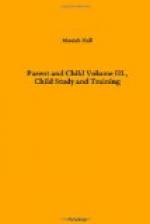It is only a step, thank fortune, from the ridiculous to the sublime, just as it is only a step from the sublime to the ridiculous. Another illustration of a perfect nervous system: You remember how our Lord spent a whole day in preaching, in healing, working deeds of kindness, in pouring out sympathy and comfort, the strain of which on a man’s nervous energy is worse than anything else in the world, and how at the close of the day He went into the little boat, took the hard cushion on which the steersman sat, threw it down in the bottom of the boat, and laid Himself down with His head on that hard cushion and slept like a child through the rocking of the boat and the roaring of the storm, until His disciples came to Him saying, “Lord, save us: we perish.” There is not one man in a thousand who could do that work or could put out one-tenth part of that nervous energy and then sleep like that. Anybody who thinks that the Prophet of Nazareth was a weak or a feeble man has made the mistake of his life. He was perfect physically or He never could have done His work.
All this work of developing a steady nerve, of developing the vital organs for the use of the muscles, has been going on until the child is nine or ten years old. It has been going on very rapidly, and in as much as the exercise has been suitable, as his digestion has been good, his growth has been very rapid. During the first three years of its life the child increases its weight more than three-fold. During the next three years it adds over forty per cent. to this amount and between six and nine adds over thirty per cent. more; and when the boy is about eleven years old, or the girl is about ten, then the growth almost stops that year. It drops to a minimum. I call your attention to this thought: the minimum growth is more in a girl than in a boy. A girl is always more precocious than a boy. She is a year older than he at nine or ten, and when she is fourteen, fifteen, sixteen, she is two years older than the boy. When the girl is ten and the boy eleven, growth drops to the minimum. Why is that? Nature is economizing her material and husbanding her resources against the trying years which are to come.
You remember the story of the time when Pharoah in his dream saw the seven fat kine followed and devoured by the seven lean kine; he was told that his dream signified seven years of plenty, to be followed by seven years of famine, and was advised to store up the harvests of the good years against the hard times to follow. This is a picture of the child’s life. The first seven years of the child’s life are years of plenty, when it is storing up material for the years of hard trial, the years of famine, which are close at hand.
I am going to talk most of the girl because she needs more attention than the boy. Growth is a very expensive process. It begins in the bone. When the bones lengthen out, then every muscle, every nerve has to be lengthened out to suit that extra length, and that means a great deal of waste for that rebuilding, but it is something worse than that. You know perfectly well that out of the butterfly egg there comes the caterpillar, and that caterpillar goes into a cocoon, and during the life of the cocoon every organ is changed there and it comes out a butterfly. That is what we call a metamorphosis.




